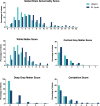Preterm brain injury on term-equivalent age MRI in relation to perinatal factors and neurodevelopmental outcome at two years
- PMID: 28486543
- PMCID: PMC5423624
- DOI: 10.1371/journal.pone.0177128
Preterm brain injury on term-equivalent age MRI in relation to perinatal factors and neurodevelopmental outcome at two years
Abstract
Objectives: First, to apply a recently extended scoring system for preterm brain injury at term-equivalent age (TEA-)MRI in a regional extremely preterm cohort; second, to identify independent perinatal factors associated with this score; and third, to assess the prognostic value of this TEA-MRI score with respect to early neurodevelopmental outcome.
Study design: 239 extremely preterm infants (median gestational age [range] in weeks: 26.6 [24.3-27.9]), admitted to the Wilhelmina Children's Hospital between 2006 and 2012 were included. Brain abnormalities in white matter, cortical and deep grey matter and cerebellum and brain growth were scored on T1- and T2-weighted TEA-MRI using the Kidokoro scoring system. Neurodevelopmental outcome was assessed at two years corrected age using the Bayley Scales of Infant and Toddler Development, third edition. The association between TEA-MRI and perinatal factors as well as neurodevelopmental outcome was evaluated using multivariable regression analysis.
Results: The distribution of brain abnormalities and brain metrics in the Utrecht cohort differed from the original St. Louis cohort (p < .05). Mechanical ventilation >7 days (β [95% confidence interval, CI]: 1.3 [.5; 2.0]) and parenteral nutrition >21 days (2.2 [1.2; 3.2]) were independently associated with higher global brain abnormality scores (p < .001). Global brain abnormality scores were inversely associated with cognitive (β in composite scores [95% CI]: -.7 [-1.2; -.2], p = .004), fine motor (β in scaled scores [95% CI]: -.1 [-.3; -.0], p = .007) and gross motor outcome (β in scaled scores [95% CI]: -.2 [-.3; -.1], p < .001) at two years corrected age, although the explained variances were low (R2 ≤.219).
Conclusion: Patterns of brain injury differed between cohorts. Prolonged mechanical ventilation and parenteral nutrition were identified as independent perinatal risk factors. The prognostic value of the TEA-MRI score was rather limited in this well-performing cohort.
Conflict of interest statement
Figures


Similar articles
-
Exploring the multiple-hit hypothesis of preterm white matter damage using diffusion MRI.Neuroimage Clin. 2017 Nov 21;17:596-606. doi: 10.1016/j.nicl.2017.11.017. eCollection 2018. Neuroimage Clin. 2017. PMID: 29234596 Free PMC article.
-
Validation of an MRI Brain Injury and Growth Scoring System in Very Preterm Infants Scanned at 29- to 35-Week Postmenstrual Age.AJNR Am J Neuroradiol. 2017 Jul;38(7):1435-1442. doi: 10.3174/ajnr.A5191. Epub 2017 May 18. AJNR Am J Neuroradiol. 2017. PMID: 28522659 Free PMC article.
-
Brain MRI Injury Patterns across Gestational Age among Preterm Infants with Perinatal Asphyxia.Neonatology. 2024;121(5):616-626. doi: 10.1159/000538986. Epub 2024 Jun 5. Neonatology. 2024. PMID: 38838655 Free PMC article.
-
Are Simple Magnetic Resonance Imaging Biomarkers Predictive of Neurodevelopmental Outcome at Two Years in Very Preterm Infants?Neonatology. 2019;116(4):331-340. doi: 10.1159/000501799. Epub 2019 Aug 27. Neonatology. 2019. PMID: 31454812
-
Comparison of cranial ultrasound and MRI for detecting BRAIN injury in extremely preterm infants and correlation with neurological outcomes at 1 and 3 years.Eur J Pediatr. 2019 Jul;178(7):1053-1061. doi: 10.1007/s00431-019-03388-7. Epub 2019 May 7. Eur J Pediatr. 2019. PMID: 31065842
Cited by
-
Budesonide and hydrocortisone have differential effects on lung and brain in ventilated preterm lambs.Pediatr Res. 2025 Jun 10. doi: 10.1038/s41390-025-04172-0. Online ahead of print. Pediatr Res. 2025. PMID: 40494863
-
Neurobehavior in very preterm infants with low medical risk and full-term infants.J Perinatol. 2022 Oct;42(10):1400-1408. doi: 10.1038/s41372-022-01432-3. Epub 2022 Jun 18. J Perinatol. 2022. PMID: 35717460 Free PMC article.
-
Neuroprotection of the Perinatal Brain by Early Information of Cerebral Oxygenation and Perfusion Patterns.Int J Mol Sci. 2021 May 20;22(10):5389. doi: 10.3390/ijms22105389. Int J Mol Sci. 2021. PMID: 34065460 Free PMC article. Review.
-
Surfactant plus budesonide decreases lung and systemic responses to injurious ventilation in preterm sheep.Am J Physiol Lung Cell Mol Physiol. 2020 Jan 1;318(1):L41-L48. doi: 10.1152/ajplung.00203.2019. Epub 2019 Oct 16. Am J Physiol Lung Cell Mol Physiol. 2020. PMID: 31617728 Free PMC article.
-
Early visuospatial attention and processing and related neurodevelopmental outcome at 2 years in children born very preterm.Pediatr Res. 2021 Sep;90(3):608-616. doi: 10.1038/s41390-020-01206-7. Epub 2020 Oct 18. Pediatr Res. 2021. PMID: 33070166
References
-
- Inder TE, Wells SJ, Mogridge NB, Spencer C, Volpe JJ. Defining the nature of the cerebral abnormalities in the premature infant: a qualitative magnetic resonance imaging study. J Pediatr 2003;143:171–9. doi: 10.1067/S0022-3476(03)00357-3 - DOI - PubMed
-
- Miller SP, Ferriero DM, Leonard C, Piecuch R, Glidden DV, Partridge JC, et al. Early brain injury in premature newborns detected with magnetic resonance imaging is associated with adverse early neurodevelopmental outcome. J Pediatr 2005;147:609–16. doi: 10.1016/j.jpeds.2005.06.033 - DOI - PubMed
-
- Childs AM, Cornette L, Ramenghi LA, Tanner SF, Arthur RJ, Martinez D, et al. Magnetic resonance and cranial ultrasound characteristics of periventricular white matter abnormalities in newborn infants. Clin Radiol 2001;56:647–55. doi: 10.1053/crad.2001.0754 - DOI - PubMed
-
- Kidokoro H, Neil JJ, Inder TE. New MR imaging assessment tool to define brain abnormalities in very preterm infants at term. AJNR Am J Neuroradiol 2013;34:2208–14. doi: 10.3174/ajnr.A3521 - DOI - PMC - PubMed
-
- Boardman JP, Craven C, Valappil S, Counsell SJ, Dyet LE, Rueckert D, et al. A common neonatal image phenotype predicts adverse neurodevelopmental outcome in children born preterm. Neuroimage 2010;52:409–14. doi: 10.1016/j.neuroimage.2010.04.261 - DOI - PubMed
MeSH terms
LinkOut - more resources
Full Text Sources
Other Literature Sources
Medical

